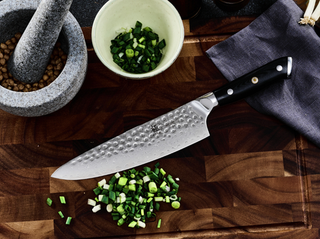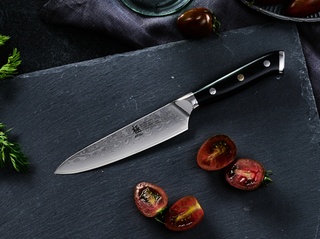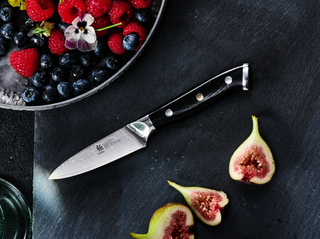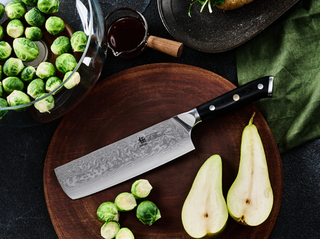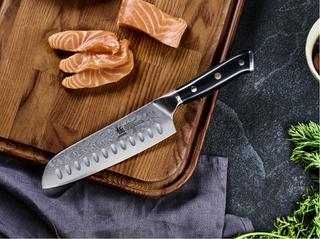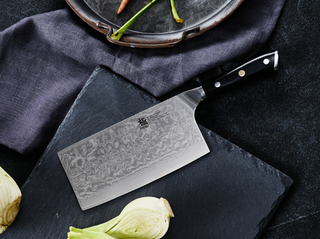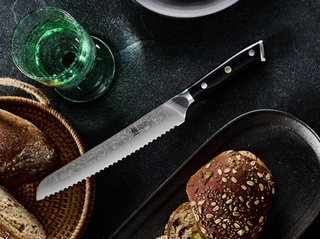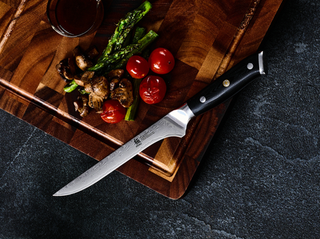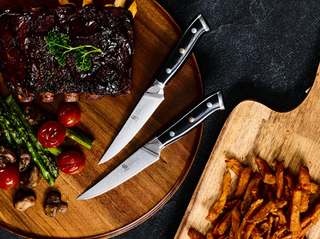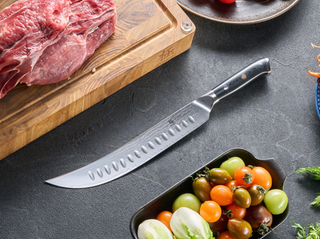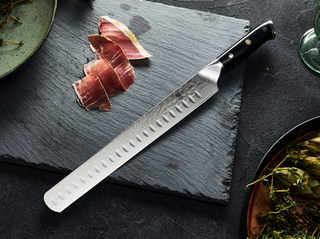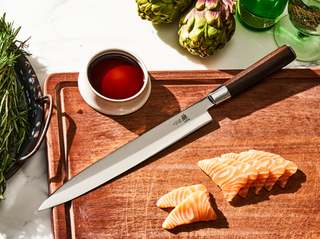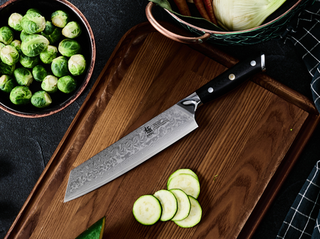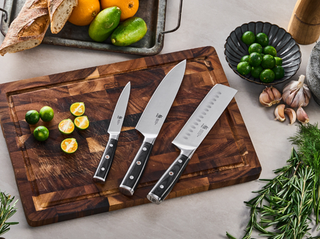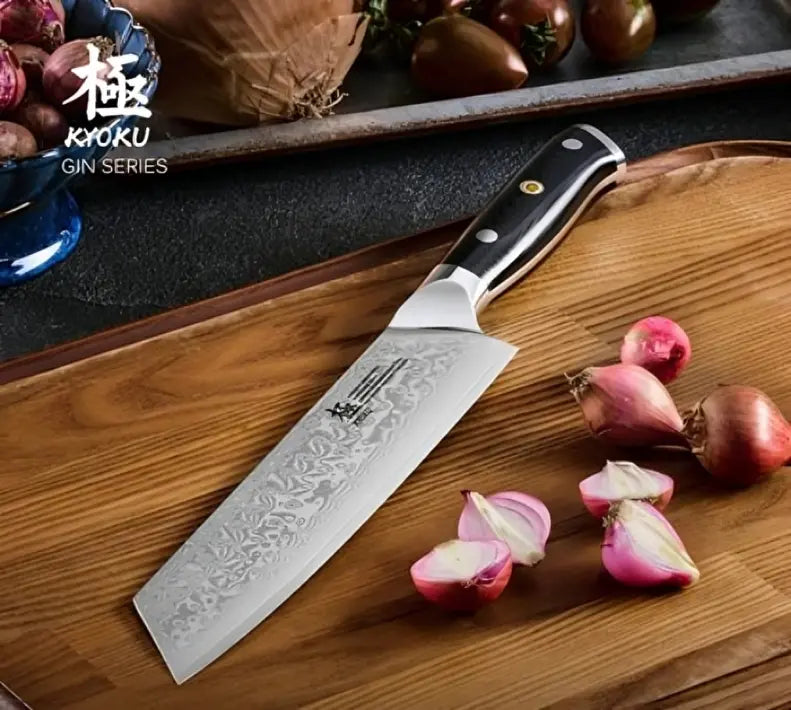kiritsuke knife is a Japanese kitchen knife that looks different from most knives you've seen. It has a straight edge and an angled tip that makes it easy to spot. Back in Japan's busy restaurant kitchens, this knife was special - only the head chef would use one. But today, more home cooks are discovering how useful it can be.
1. What Makes a Quality Kiritsuke Knife? Materials and Design

When you're looking at kiritsuke knives, knowing what goes into making a good one helps you make a smart choice.
These knives typically range from 210mm to 330mm in length - that's about 8.3 to 13 inches. The length isn't just for show - it helps you make those long, clean cuts through vegetables and fish without having to saw back and forth.
Most quality kiritsuke knives use high-carbon steel because it holds a sharper edge longer than regular stainless steel.
You'll often see terms like "blue steel" or "white steel" - these are traditional Japanese steels known for taking and keeping an extremely sharp edge. Some modern versions use stainless steel, which is easier to maintain.
The knife handle also makes a big difference in how the kiritsuke knife feels and works.
Traditional Japanese handles (wa-handles) are lighter and more balanced toward the blade. Western-style handles give you a more familiar grip if you're used to European knives. Neither is better - it's about what feels comfortable in your hand.
2. Whether Kiritsuke Knife is Suitable for Home Cooks vs Professional

Many people wonder if a kiritsuke knife is too advanced for their kitchen. The truth is, while traditional single-bevel kiritsuke knives take practice to master, modern double-bevel versions are much easier to use. A single-bevel knife has the cutting edge on just one side, while a double-bevel has it on both sides - like most kitchen knives you're familiar with.
If you're just starting with Japanese knives, look for a double-bevel kiritsuke. These handle more like a regular chef's knife but still give you the benefits of the kiritsuke's unique shape. The flat blade helps you cut in smooth, even strokes instead of the rocking motion you might be used to with Western knives.
For home cooks looking to explore kiritsuke knives, Kyoku's 8.5" Damascus Steel Kiritsuke Knife offers an accessible entry point - its double-bevel design and 58-60 Rockwell hardness damascus steel blade combines traditional Japanese craftsmanship with modern usability, making it easier to achieve those precise cuts while you develop your technique.
3. Kiritsuke vs Other Kitchen Knives
When comparing a kiritsuke to other knives, think about how you cook.
A Western chef's knife is more forgiving if you're used to rocking the blade while chopping.
Compare to Kiritsuke, a santoku knife is shorter and might be easier to control for everyday tasks.
But a kiritsuke gives you more blade length for slicing and a flatter edge that many cooks find perfect for push-cutting through vegetables.
-
Learning to use a kiritsuke takes some practice, but it's not as difficult as you might think.
-
Start by keeping the blade straight up and down - this helps you make clean cuts.
-
Use a push-forward motion rather than rocking the blade.
-
Let the knife's weight and sharpness do the work instead of pressing down hard.
These simple techniques will help you get comfortable with the knife's unique cutting style.
4. What Can You Actually Cut With a Kiritsuke Knife?
Many people are curious about the Kiritsuke knife use. The long, flat blade excels at slicing raw fish for sushi, cutting meat into thin strips, and chopping vegetables.
What is a Kiritsuke Knife Used For
The kiritsuke's flat blade and angled tip make it particularly effective for precise vegetable preparation, especially with delicate ingredients used in Japanese cuisine.
When preparing daikon radish for simmered dishes or pickles, the flat edge helps create those perfectly even, thin slices that allow the radish to cook uniformly and absorb flavors well.
The knife's length lets you cut through the entire daikon in one smooth motion, rather than requiring multiple shorter cuts that might leave rough edges.
Cutting Vegetable
For leafy greens like cabbage or lettuce, the kiritsuke's design prevents the crushing that often happens with curved-blade knives. When making shredded cabbage for tonkatsu, for example, the flat edge allows for the paper-thin slices that give Japanese coleslaw its characteristic light, crisp texture. The blade's length helps maintain consistent thickness across the entire cut.
Clean Meat Cut
With proteins, the kiritsuke excels at tasks that require precise angled cuts. When preparing sashimi from fish like tuna or salmon, the long, flat blade helps achieve those clean, single-stroke cuts that are essential for proper texture and presentation. The angled tip proves especially useful for removing skin from fish fillets or trimming silver skin from meat - tasks where precision and control are crucial.
Recipes With Kiritsuke
In traditional Japanese cooking, the kiritsuke often serves as the primary knife for preparing usuzukuri - paper-thin slices of white-fleshed fish for dishes like tai usuzukuri (thinly sliced sea bream).
The blade's length and flatness allow for the continuous, drawing cuts needed to achieve nearly transparent slices without sawing or tearing the delicate flesh.
For everyday cooking tasks, the kiritsuke's versatility shows in prep work like:
-
Julienning carrots or cucumber for salads, where the flat edge helps maintain consistent thickness
-
Chopping herbs like green onions, where clean cuts prevent bruising and preserve freshness
-
Breaking down whole chickens, where the angled tip helps navigate joints and separate meat from bone
-
Slicing blocks of tofu, where the knife's sharpness and length create clean edges without crumbling
These specific kiritsuke knife uses explain why Japanese chefs favor and value the kiritsuke's design.
Learning to use a kiritsuke takes some practice, but it's not as difficult as you might think. Start by keeping the blade straight up and down - this helps you make clean cuts. Use a push-forward motion rather than rocking the blade. Let the knife's weight and sharpness do the work instead of pressing down hard. These simple techniques will help you get comfortable with the knife's unique cutting style.
5. Common Questions About Kiritsuke Knives

"Is a kiritsuke knife worth it for home cooks?"
For home cooks who enjoy Japanese cuisine and precise knife work, a kiritsuke knife can be a valuable addition to your kitchen. While the traditional single-bevel kiritsuke takes practice to master, modern double-bevel versions offer similar benefits with an easier learning curve. If you often prepare fish, vegetables, or dishes requiring precise cuts, you'll find the kiritsuke's unique design especially useful. However, if you're just starting with Japanese knives, you might want to begin with a santoku or gyuto before moving to a kiritsuke.
"What's the main difference between single-bevel and double-bevel kiritsuke?"
A single-bevel kiritsuke has the cutting edge only on one side of the blade, making it more specialized and typically requiring more skill to use properly. Traditional Japanese chefs prefer single-bevel kiritsuke for its ability to make extremely precise cuts, especially in fish and vegetables. Double-bevel kiritsuke knives have the edge ground on both sides, similar to Western knives. This makes them more versatile and easier to use for most home cooks, though they might not achieve quite the same level of precision as a single-bevel blade.
"How often should I sharpen my kiritsuke knife?"
Your sharpening schedule depends on how often you use the knife and what you're cutting. For regular home use, honing the edge with a ceramic rod every few uses helps maintain sharpness. Full sharpening with whetstones is typically needed every 3-4 months for home cooks who use their kiritsuke regularly. Professional cooks might need to sharpen more frequently. The key is to sharpen before the knife becomes noticeably dull - if you're having to apply pressure to make cuts, it's time to sharpen.
"Can I use a kiritsuke knife as my main chef's knife?"
Many cooks successfully use a kiritsuke as their primary knife, especially the double-bevel version. The long, flat blade works well for most cutting tasks, from chopping vegetables to slicing meat. However, if you're used to the rocking motion of Western chef's knives, you'll need to adjust your cutting technique to more of a push-cut or pull-cut style. Some cooks prefer having both a kiritsuke and a Western chef's knife to handle different cutting styles.
"Why does a kiritsuke knife have that distinctive angled tip?"
The angled tip (called a reverse tanto point) serves several practical purposes. It helps with precise tip work, like removing fat from meat or making detailed cuts in vegetables. The angle also strengthens the tip compared to a regular pointed end, making it less likely to break during use. This design feature comes from traditional Japanese sword-making techniques and helps make the knife more durable while maintaining its precision capabilities.
6. Conclusion: Is a Kiritsuke Knife Right for Your Kitchen?
A kiritsuke knife stands out in Japanese cuisine for good reason. Its flat blade and angled tip let you make those clean, precise cuts that turn basic ingredients into beautifully prepared dishes. In home kitchens, this knife shines when you need to slice fish in smooth, single strokes or cut vegetables into uniform pieces that cook evenly.
Starting with a double-bevel kiritsuke makes sense for most home cooks. It feels more natural in your hand than traditional single-bevel models, while still giving you the benefits of the kiritsuke's distinctive design. As you work with it more, you'll find your cutting technique becoming smoother and more confident.
The kiritsuke knife brings professional-level precision to home cooking. Its design helps you develop better knife skills while giving you the tools to prepare ingredients the way you see in cooking shows and restaurants. Once you get comfortable with its straight cutting motion, you'll understand why so many cooks reach for their kiritsuke knife first.

Ready to explore kiritsuke knives? Check out Kyoku's collection of handcrafted Japanese kitchen knives. You'll find the perfect kiritsuke knife along with other essential Japanese blades to elevate your cooking.
